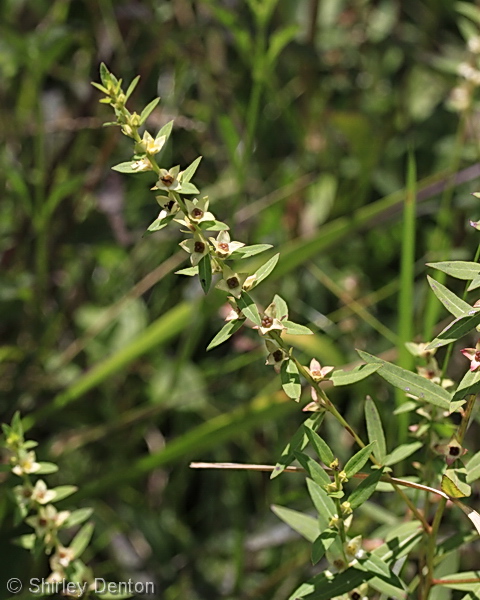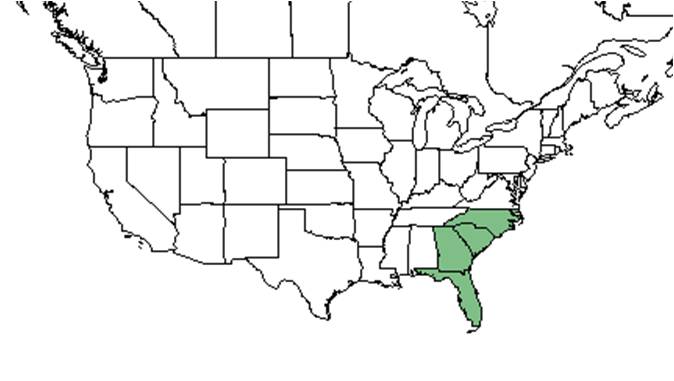Ludwigia lanceolata
| Ludwigia lanceolata | |
|---|---|

| |
| Photo by Shirley Denton (Copyrighted, use by photographer’s permission only), Nature Photography by Shirley Denton | |
| Scientific classification | |
| Kingdom: | Plantae |
| Division: | Magnoliophyta - Flowering plants |
| Class: | Magnoliopsida – Dicotyledons |
| Order: | Myrtales |
| Family: | Onagraceae |
| Genus: | Ludwigia |
| Species: | L. lanceolata |
| Binomial name | |
| Ludwigia lanceolata Elliott | |

| |
| Natural range of Ludwigia lanceolata from USDA NRCS Plants Database. | |
Common names: Lanceleaf primrose-willow, Lanceleaf seedbox
Contents
Taxonomic notes
Synonym: L. alata
The genus Ludwigia was established by Carl Linnaeus in 1753 and the species was recognized by Steven Elliot. [1]
Description
“Repent or erect, usually branched, short-lived perennials, or rarely annual. Floral parts in 4-7’s; hypanthium not prolonged beyond ovary. Capsules longitudinally or poricidally multiseriate, rarely uniseriate. Most of the erect species produce basal offshoots, which have ovate to obovate leaves, in the late summer and fall. Bracteoles occur in pairs on the pedicel or stipe or on the base of the hypanthium.” [2]
"Similar to L. alata. Seeds cylindric; sepals ca. ½ length of capsules; capsules 4-6 mm long." [2]
Distribution
Occurs along the Atlantic coast of southern North Carolina, South Carolina, eastern and southern Georgia, and the Florida peninsula, and extends west to the central panhandle of Florida. [1]
Ecology
Habitat
Habitats of L. lanceolata include depression marshes, hillside seepages, shallow water of titi-cattail ponds, pine flatwoods, lake edges, between coastal dunes and lakes, and cypress pond pine swamps. It occurs in disturbed areas such as powerline corridors and ditches. Associated species include Bidens laevis, Magnolia, Nyssa, Pickneya, Liquidambar, Quercus, Ludwigia linearis, Juncus trigonocarpus, Fuirena scirpoidea, Xyris fimbriata, Woodwardia, Ludwigia octovalvis, L. decurrens, Rhynchospora chalarocephala, Xyris fimbriata, Bidens mitis, Hypericum cistifolium, Typha, and Juncus repens. [3]
Phenology
Fruits and flowers June through November. [3]
This is a self-compatible perennial that reproduces sexually and vegetatively. Produces hybrids with L. pilosa and L. suffruticosa. [1]
Pollination
The following Hymenoptera families and species were observed visiting flowers of Ludwigia lanceolata at Archbold Biological Station: [4]
Vespidae: Parancistrocerus salcularis rufulus
Conservation and management
Global status: G3
Global status last reviewed: March 6, 1998.[5]
Cultivation and restoration
Photo Gallery
References and notes
- ↑ 1.0 1.1 1.2 Ching, I. P. (1989). "The Systematics and Evolution of Ludwigia Sect. Microcarpium (Onagraceae)." Annals of the Missouri Botanical Garden 76(1): 221-302.
- ↑ 2.0 2.1 Radford, Albert E., Harry E. Ahles, and C. Ritchie Bell. Manual of the Vascular Flora of the Carolinas. 1964, 1968. The University of North Carolina Press. 744-9. Print.
- ↑ 3.0 3.1 Florida State University Robert K. Godfrey Herbarium database. URL: http://herbarium.bio.fsu.edu. Last accessed: October 2015. Collectors: C. Anderson, Robert K. Godfrey, Richard D. Houk, R. Kral, Grady W. Reinert. States and Counties: Florida: Clay, Franklin, Madison, Nassau, Osceola, Santa Rosa, St. Johns, St. Lucie, Taylor, Wakulla, Walton. Compiled by Tall Timbers Research Station and Land Conservancy.
- ↑ Deyrup, M.A. and N.D. 2015. Database of observations of Hymenoptera visitations to flowers of plants on Archbold Biological Station, Florida, USA.
- ↑ [NatureServe]Accessed: February 5, 2016